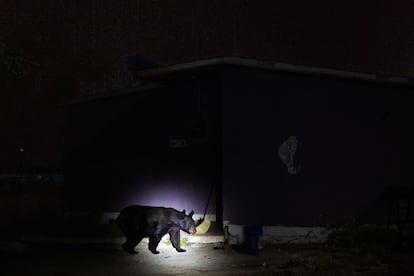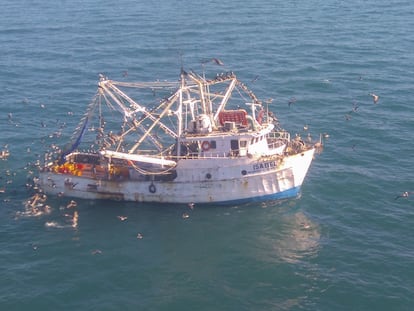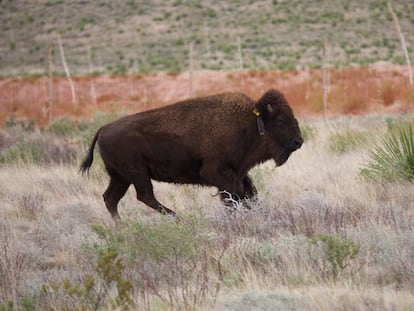Why are more and more black bears showing up in Mexican cities?
Sightings of these animals in cities, particularly across the northern Mexican state of Nuevo León, are becoming more frequent. The authorities are trying to find a solution that will protect this endangered species


Black bears have been run over, improperly castrated, or starved. They’ve entered houses, schools and shopping malls. Oftentimes, their digestive systems have been clogged by plastics, which they’ve accidentally consumed while eating from the garbage. Ursus americanus — considered to be an endangered species — has come down from the mountains of Mexico and is roaming the streets of Monterrey and other large cities across the northern state of Nuevo León. They wander freely until someone notifies the authorities, who decide the fate of each individual bear, based on its history of violence and how often it descends into urban areas. Since 2008, 244 of these mammals have been captured and displaced, according to the Parks and Wildlife Department of Nuevo León (PVSNL).
Faced with complaints from animal advocacy organizations, the organization refers to a protocol that they implement every time they receive a report of a bear in a human community. Edgar Acosta, the general director of PVSNL, is in charge of deciding what happens to the bears, alongside the Federal Attorney for Environmental Protection (Profepa) and the Civil Protection Directorate. “We have to think about the safety of people and, at the same time, the safety of the animals. [The black bear] is a species that may seem likeable, but the reality is that bears are a totally unpredictable wild species.”
Since the buildings, houses and pools (which the bears sometimes bathe in) cannot be moved, it’s the black bears who end up suffering from the stress of being forcibly relocated to a new habitat. “The bears are the ones who decide their destiny,” says Acosta. Authorities use something they call a “Risk Traffic Light,” a decision system that indicates the bear’s future, based on the animal’s past and present behavior. For example, if the bear follows or harasses a person in an urban environment, the creature is classified as being of medium-high risk. Therefore, it would be appropriate to handle the animal via sedation or trapping and release him or her back into their habitat.
Monterrey is the third-largest city in Mexico and the capital of Nuevo León. As its population increased, the wealthiest inhabitants gradually moved to the foothills of the mountains that surround a city of just over five million inhabitants. Every so often, a new video pops up featuring a bear terrorizing — or hugging — a passerby. This past April, a family from Monterrey were forced to flee when a huge bear chased them through the corridors of a cabin in the town of Ciénega de González, an hour’s drive from Monterrey.
In March, images of a bear emerged in the Lagos del Vergel neighborhood, also in Monterrey, while it took a dip in a pool to cool off from the historic heatwave that was plaguing the region. Then, the animal got out of the pool to play with the branches of the trees in the garden, until it got bored and plunged back into the leafy forest. And, last May, a black bear, a young specimen, had to be captured, because he was wandering aimlessly through the streets of Monterrey, bumping into cars, clearly disoriented.
Sometimes, however, despite the risk system and a collaborative decision-making process between institutions, the authorities make mistakes that end up appearing in the national press. For instance, in August of 2020, a specialized veterinarian from the Autonomous University of Nuevo León received a 211-pound bear that had been seen eating out of the garbage and “socializing” with passersby in a park. The authorities decided that the best course of action given the history of the bear’s comfort with human populations was to release it in the Sierra de Nido, in the state of Chihuahua. The problem was that another very territorial breed of bear lives in that mountain range. Hence — in an attempt to prevent the black bear from Nuevo León from having adaptation problems — they decided to castrate the animal.
The decision caused a huge debate. Adriana Cela, a biologist in Mexico City, who works for the organization Animal Heroes, fears that the authorities simply sent the bear off to its death. “It’s very stressful for a bear to arrive in a new territory that it doesn’t know and to have to fight again for its territory… [it’s very difficult to have to] fight with other bears to conquer the space, without knowing where the food sources are, either. Who knows what happened to that poor animal,” she says by phone.
It’s also not clear that returning black bears to their natural habitat is the best option. “It’s much easier to feed on the garbage from bins than on the ants from a tree,” Cela notes. Acosta also seems concerned about this strategy: “The bears seek to return to where they perceive that they’ve found a delicacy… which, for them, is food from the garbage.” The youngest bears that are appearing in videos on the streets of Monterrey appear to have learned this behavior from their mothers.
In 2015, the authorities dealt with the case of a female black bear with her two cubs. They were feeding on the garbage generated by a recreational center in Parque Chipinque, on the outskirts of Monterrey. The animals were trapped in cages and returned to their natural habitat but experts say that now it’s the bear cubs who have returned to the city. They’re interacting with people instead of fleeing from them, while feeding on the garbage. Cela warns that this poses a risk, because the food from the bins doesn’t give the bears adequate nutrition. Discarded food also has additives and fats that damage the bears’ liver and kidneys.
Acosta goes one step further: “Today, when we find dead specimens with clear signs of malnutrition, the most likely thing that we find during the autopsy is a plastic bag obstructing the digestive system.” So what’s the solution? In his recurring messages to the population, he tells residents that — apart from not interacting with the bears and not feeding them — it’s crucial not to leave garbage easily available to these animals, either on the street or in other accessible places. “Garbage has to be deposited in bear-proof bins, which are already being sold,” the director of Parks and Wildlife stresses.
Sign up for our weekly newsletter to get more English-language news coverage from EL PAÍS USA Edition
Tu suscripción se está usando en otro dispositivo
¿Quieres añadir otro usuario a tu suscripción?
Si continúas leyendo en este dispositivo, no se podrá leer en el otro.
FlechaTu suscripción se está usando en otro dispositivo y solo puedes acceder a EL PAÍS desde un dispositivo a la vez.
Si quieres compartir tu cuenta, cambia tu suscripción a la modalidad Premium, así podrás añadir otro usuario. Cada uno accederá con su propia cuenta de email, lo que os permitirá personalizar vuestra experiencia en EL PAÍS.
¿Tienes una suscripción de empresa? Accede aquí para contratar más cuentas.
En el caso de no saber quién está usando tu cuenta, te recomendamos cambiar tu contraseña aquí.
Si decides continuar compartiendo tu cuenta, este mensaje se mostrará en tu dispositivo y en el de la otra persona que está usando tu cuenta de forma indefinida, afectando a tu experiencia de lectura. Puedes consultar aquí los términos y condiciones de la suscripción digital.
More information
Archived In
Últimas noticias
Most viewed
- David King, chemist: ‘There are scientists studying how to cool the planet; nobody should stop these experiments from happening’
- Reinhard Genzel, Nobel laureate in physics: ‘One-minute videos will never give you the truth’
- Mexico completes its trade shift with the entry into force of tariffs on China and countries without trade agreements
- Oona Chaplin: ‘I told James Cameron that I was living in a treehouse and starting a permaculture project with a friend’
- Sinaloa Cartel war is taking its toll on Los Chapitos










































